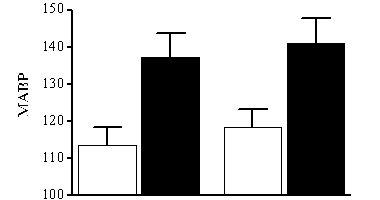| pA2 online © Copyright 2004 The British Pharmacological Society |
070P
GKT, University of London Winter Meeting December 2003 |
|
Endothelial
cell endothelin B receptors mediate a tonic hypotensive effect that
is insensitive to salt |
|
Endothelin-1 (ET-1) is a locally active hormone with potent effects as a vasoconstrictor and growth factor (Yanagisawa et al., 1988). ET-1 activates both endothelin A receptors and endothelin B receptors (ETBR) on vascular smooth muscle to increase vascular tone, whilst activation of ETBR on endothelial cells (EC) causes vasodilatation, making interpretation of pharmacological studies of ETBR activation difficult. Rescued ETBR-deficient rats exhibit salt sensitive hypertension, suggesting that ETBR are also involved in natriuresis (Gariepy et al., 2000). However, because this model features knockout (KO) of ETBR in all tissues concurrently, the precise cellular location of ETBR responsible for this phenotype has not been determined. By crossing floxed ETBR mice (FF/--) with Tie2-Cre mice (WW/Tie2), we have generated an EC-specific ETBR KO mouse (FF/Tie2) to investigate the role and relative contribution of the EC ETBR to the regulation of blood pressure under normal and high salt conditions.
Male FF/Tie2 and wild type (WT) mice were studied (8-20 weeks; 25-35g). Blood was sampled by cardiac puncture and plasma ET-1 concentrations were determined by radioimmunoassay. In a further study, mice were fed either normal (0.8% NaCl) or high salt (7.6% NaCl) diet for 21 days. A catheter was then inserted into the carotid artery of each mouse under isoflurane anaesthesia. Arterial BP measurements were made under conscious, unrestrained conditions 48 hours following surgery.
EC ETBR KO mice have raised levels of circulating ET-1 (Table 1) and exhibit mild hypertension that is not salt sensitive (Figure 1).
| Genotype |
WW/--
|
WW/Tie2
|
FF/--
|
FF/Tie2
|
| [ET-1] |
2.9±0.8
|
3.0±0.8
|
4.0±0.5
|
12.4±3.0*
|
Table 1: Values (pg.ml-1) are mean±SEM (n=6; *p<0.001, Bonferrroni following 1-way ANOVA).

|
Genotype
|
WW/--
|
FF/Tie2
|
WW/--
|
FF/Tie2
|
|
Dietary
sodium
|
0.8%
|
0.8%
|
7.6%
|
7.6%
|
Figure 1: Mean arterial blood pressure of conscious unrestrained wild type and FF/Tie2 mice on normal or high salt diet (n=5; *p<0.05, Bonferroni following 2-way ANOVA).
These studies provide important evidence suggesting that EC ETBR are involved in clearance of ET-1 and exert a tonic hypotensive effect this is not altered by salt. This suggests that the EC ETBRs do not influence ET-1 dependent natriuresis.
GARIEPY, C.E., et al. (2000). J Clin Invest, 105, 925-33.
YANAGISAWA, et al. (1988). Nature, 332, 411-5.
This research was funded by the British Heart Foundation (FS/03/006/15108) and the Wellcome Trust.